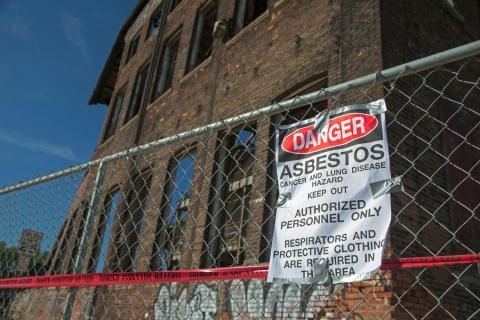
Once asbestos enters the lungs, it doesn’t leave. Its sharp, microscopic fibres scar tissues, trigger inflammation and can cause deadly diseases like mesothelioma, lung cancer and laryngeal cancer. That’s why over 60 countries have banned it – and why the US mostly phased it out.
In 2024, the Environmental Protection Agency (EPA) moved to ban all industrial uses. But on June 17, the agency said it would revisit the Biden‑era ban.
Asbestos is a naturally occurring silicate mineral made of thin, fibrous crystals. It is fire-resistant, durable, lightweight, flexible and insulating. This unique blend of properties resulted in its widespread use over millennia. Indeed, asbestos fibres have been found woven into pottery and textiles from 2500 BC.
Its resistance to friction and electricity made it desirable during the Industrial Revolution for use in boilers and steam engines. In the 20th century, the useful mix of physical properties resulted in asbestos becoming ubiquitous in the construction and automotive industries, peaking in the 1970s.
Although the properties of asbestos at the macroscopic level are beneficial, at the microscopic level it’s anything but. When dust from asbestos (0.1 to tens of microns) is inhaled, it deposits throughout the respiratory system, causing inflammation and scarring of lung tissue.
While the adverse health effects associated with asbestos exposure were observed in ancient Rome, it wasn’t until the 20th century that the full extent of harm was realised. Specifically, asbestos exposure is linked to numerous respiratory diseases, including mesothelioma, lung cancer and asbestosis.
It took a long time for people to understand how dangerous asbestos really is. The main reason is that the illnesses it causes often don’t show up for decades. This long delay makes it very hard to link exposure to the disease it causes.
Making this connection is also made more difficult when those most familiar with it, including manufacturers such as Johns-Manville and industry groups such as the Asbestos Information Association (AIA) were actively denying the connection, and suppressing reports demonstrating the link.
By the 1970s, the volume of evidence showing the harms of asbestos had become overwhelming. The AIA evolved its argument, claiming that the practices in the industry had changed and that the risks were from a bygone era “when the dust control equipment in use was not as efficient or as sophisticated”. Although the association never explicitly admitted that asbestos caused harm.
Since it can take decades for the health effects of asbestos exposure to fully manifest, the full extent of the damage caused by asbestos exposure from the 1970s and onward, an era where the dust control equipment was claimed to be “efficient and sophisticated”.
The Asbestos Information Association, once a key industry group promoting the safe use of asbestos, quietly disbanded in the early 2000s as litigation and public health evidence mounted.
History of asbestos.
What type of asbestos is the US considering unbanning?
The EPA is considering unbanning chrysotile asbestos, also called white asbestos. This type of asbestos is often used in things like brake pads, gaskets and industrial equipment. In March 2024 the EPA banned it, stopping new uses and imports. The ban also included a gradual phase-out plan.
Who is pushing for the unbanning and why now?
From the outset, industry groups such as the American Chemistry Council (ACC) raised concerns about the EPA’s ban, warning that “a prohibition of an estimated 52% of annual production volume … that rapidly, could have substantial supply chain impacts”, particularly if manufacturers were bound by existing contracts or chose to cease production entirely.
As for why now, one factor is the re-election of Donald Trump, who put his views on record some time ago downplaying the dangers of asbestos. In 1997, he wrote in his book Trump: The Art of the Comeback that asbestos is “100 percent safe, once applied”. A point not supported by the best available science.
Why is the EPA considering unbanning it?
According to former ACC employee and current senior official in EPA’s Office of Chemical Safety and Pollution Prevention Lynn Ann Dekleva, they want to consider if the ban “went beyond what is necessary to eliminate the unreasonable risk and whether alternative measures — such as requiring permanent workplace protection measures – would eliminate the unreasonable risk”.
What industries still want to use this type of asbestos?
The largest push appears to be coming from the chlor-alkali industry where they use it to produce chlorine and sodium hydroxide.
Is this type of asbestos dangerous?
Yes. There is no safe level of exposure.
How many people could this affect?
Each year, around 40,000 deaths in the US and about 5,000 in the UK are attributed to asbestos exposure. If lifted, it’s possible that the number in the US could increase over the coming decades while those in the UK will continue to fall.
Does this mean asbestos could make a comeback elsewhere too?
Unlikely. While global consensus moves toward stricter regulation, the US now finds itself at a crossroads, between scientific evidence and pressure from industry.
By Allen Haddrell, Research Fellow, School of Chemistry, University of Bristol. This article is republished from The Conversation under a Creative Commons license. Read the original article.
![]()